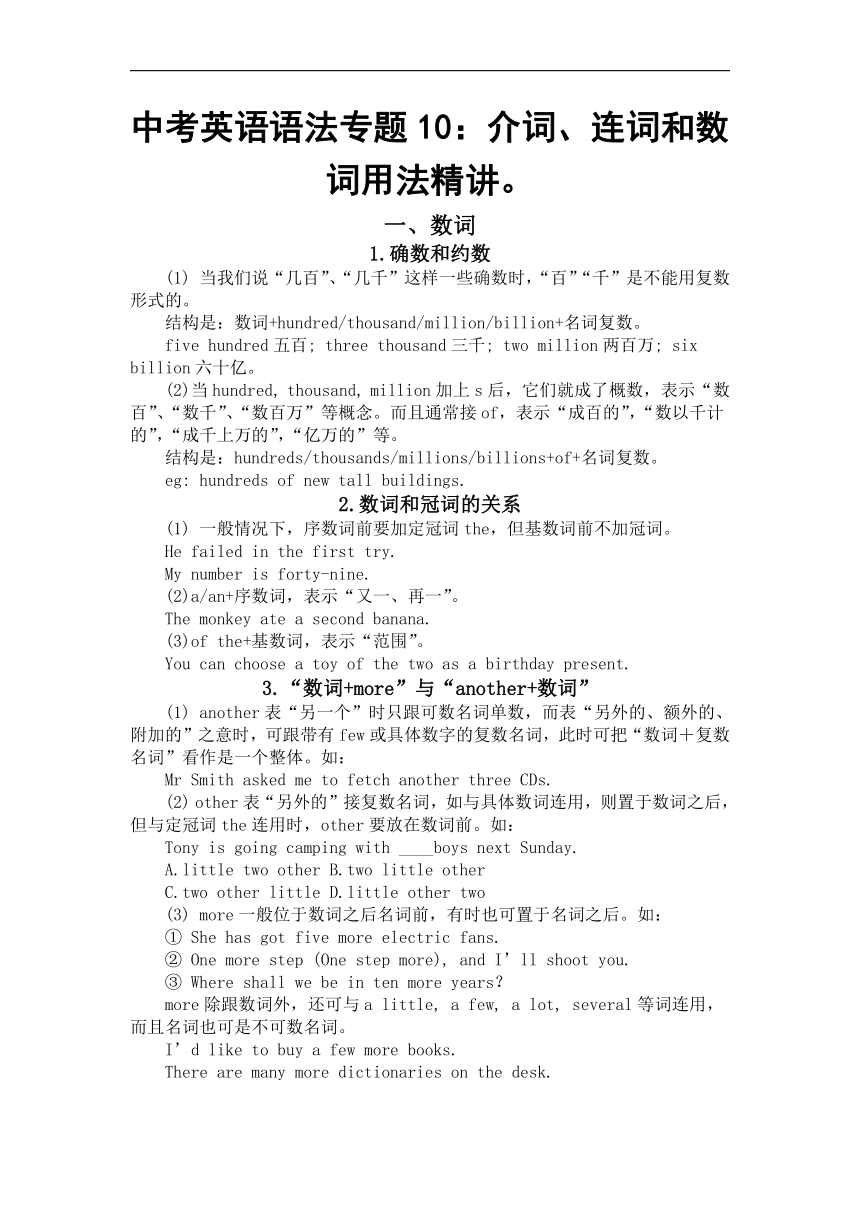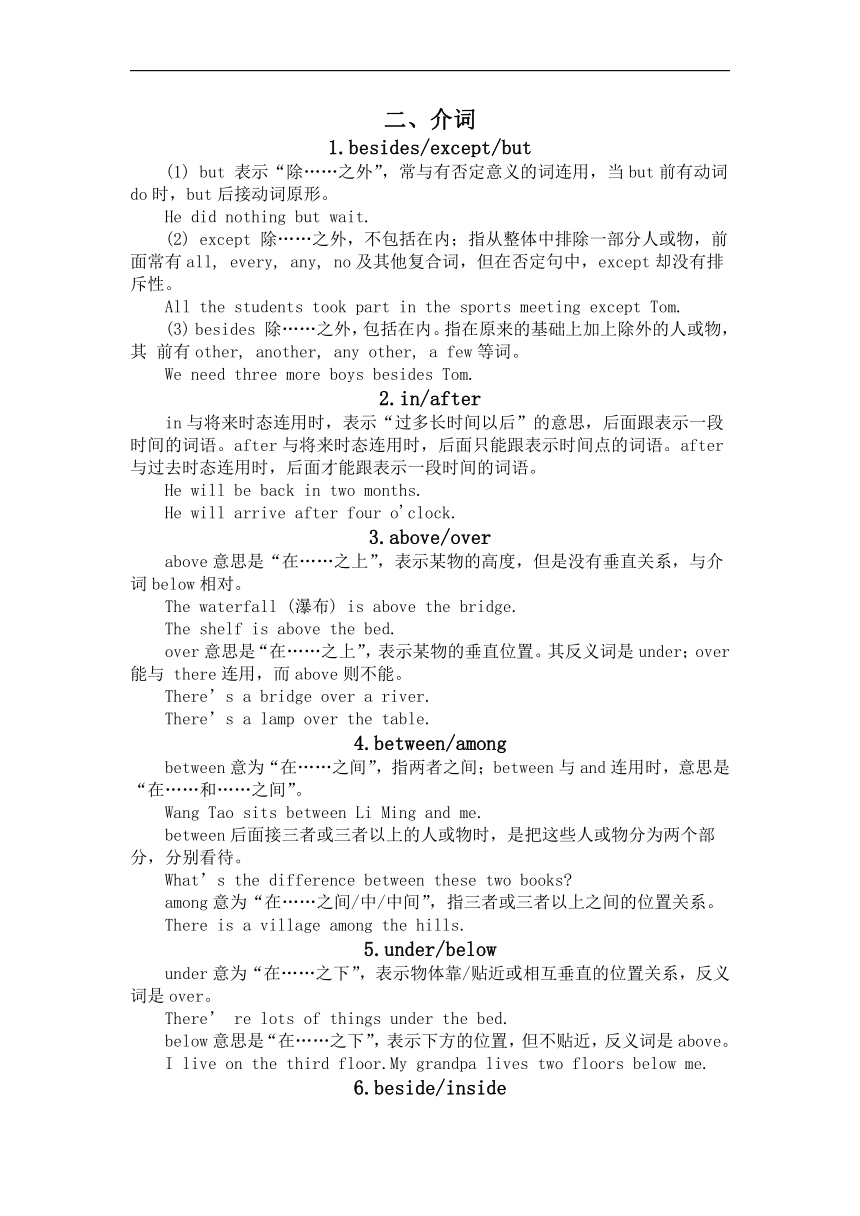2023年中考英语复习语法知识精讲(数词+介词+连词)
文档属性
| 名称 | 2023年中考英语复习语法知识精讲(数词+介词+连词) |  | |
| 格式 | zip | ||
| 文件大小 | 31.4KB | ||
| 资源类型 | 教案 | ||
| 版本资源 | 北师大版 | ||
| 科目 | 英语 | ||
| 更新时间 | 2023-04-12 13:00:57 | ||
图片预览


文档简介
中考英语语法专题10:介词、连词和数词用法精讲。
一、数词
1.确数和约数
(1) 当我们说“几百”、“几千”这样一些确数时,“百”“千”是不能用复数形式的。
结构是:数词+hundred/thousand/million/billion+名词复数。
five hundred五百; three thousand三千; two million两百万; six billion六十亿。
(2)当hundred, thousand, million加上s后,它们就成了概数,表示“数百”、“数千”、“数百万”等概念。而且通常接of,表示“成百的”,“数以千计的”,“成千上万的”,“亿万的”等。
结构是:hundreds/thousands/millions/billions+of+名词复数。
eg: hundreds of new tall buildings.
2.数词和冠词的关系
(1) 一般情况下,序数词前要加定冠词the,但基数词前不加冠词。
He failed in the first try.
My number is forty-nine.
(2)a/an+序数词,表示“又一、再一”。
The monkey ate a second banana.
(3)of the+基数词,表示“范围”。
You can choose a toy of the two as a birthday present.
3.“数词+more”与“another+数词”
(1) another表“另一个”时只跟可数名词单数,而表“另外的、额外的、附加的”之意时,可跟带有few或具体数字的复数名词,此时可把“数词+复数名词”看作是一个整体。如:
Mr Smith asked me to fetch another three CDs.
(2) other表“另外的”接复数名词,如与具体数词连用,则置于数词之后,但与定冠词the连用时,other要放在数词前。如:
Tony is going camping with ____boys next Sunday.
A.little two other B.two little other
C.two other little D.little other two
(3) more一般位于数词之后名词前,有时也可置于名词之后。如:
① She has got five more electric fans.
② One more step (One step more), and I’ll shoot you.
③ Where shall we be in ten more years?
more除跟数词外,还可与a little, a few, a lot, several等词连用,而且名词也可是不可数名词。
I’d like to buy a few more books.
There are many more dictionaries on the desk.
二、介词
1.besides/except/but
(1) but 表示“除……之外”,常与有否定意义的词连用,当but前有动词do时,but后接动词原形。
He did nothing but wait.
(2) except 除……之外,不包括在内;指从整体中排除一部分人或物,前面常有all, every, any, no及其他复合词,但在否定句中,except却没有排斥性。
All the students took part in the sports meeting except Tom.
(3) besides 除……之外,包括在内。指在原来的基础上加上除外的人或物,其 前有other, another, any other, a few等词。
We need three more boys besides Tom.
2.in/after
in与将来时态连用时,表示“过多长时间以后”的意思,后面跟表示一段时间的词语。after与将来时态连用时,后面只能跟表示时间点的词语。after与过去时态连用时,后面才能跟表示一段时间的词语。
He will be back in two months.
He will arrive after four o'clock.
3.above/over
above意思是“在……之上”,表示某物的高度,但是没有垂直关系,与介词below相对。
The waterfall (瀑布) is above the bridge.
The shelf is above the bed.
over意思是“在……之上”,表示某物的垂直位置。其反义词是under;over能与 there连用,而above则不能。
There’s a bridge over a river.
There’s a lamp over the table.
4.between/among
between意为“在……之间”,指两者之间;between与and连用时,意思是“在……和……之间”。
Wang Tao sits between Li Ming and me.
between后面接三者或三者以上的人或物时,是把这些人或物分为两个部分,分别看待。
What’s the difference between these two books
among意为“在……之间/中/中间”,指三者或三者以上之间的位置关系。
There is a village among the hills.
5.under/below
under意为“在……之下”,表示物体靠/贴近或相互垂直的位置关系,反义词是over。
There’ re lots of things under the bed.
below意思是“在……之下”,表示下方的位置,但不贴近,反义词是above。
I live on the third floor.My grandpa lives two floors below me.
6.beside/inside
beside意为“在……的旁边/附近”,等于at the side of,其同义词是near/close to。有时可以与by互换使用。
Kate sits beside/by Sandy.
inside意思是“在……里面”,表示具体的位置关系,其反义词是outside。
Kate’s toys are inside the box.
7.through/across/across from
through和across都表示“穿过”,“通过”的意思,across表示从物体表面“穿过”、“通过”;而through则表示从内部或空间“穿过”、“通过”。across from 相当于opposite,美国英语中常用。
He went across the hall to the door.
They are building a tunnel, and it will go through the mountain.
8.in front of/in the front of
in front of 是短语介词,之后可以跟名词或代词作宾语,意为“在……的前面”,其反义词是behind,说明人与物,物与物之间的相对位置,即不在同一范围内。in the front of是介词短语,之后跟名词或代词作宾语,意思是“在……的前部”,说明某人/物在同一范围内。
There’s a big tree in front of the house.
The teacher sits in the front of the classroom.
9.for sb./of sb.
在句型It is +形容词+ of/for + sb + to do sth.中,用of还是用for取决于形容词,如果形容词是描述人物性格特征,后面的人与形容词有主语和表语的关系,用介词of,形容词常用clever, kind, nice等;如果形容词是说“事”的用介词for,形容词常用easy, important, necessary等。
【注意】两个句型的正确翻译。
It’s important for us to learn English well.
It’s kind of you to help me with my English.
三、连词
1.as/while/when,
as用作连词时,含义比较多;
引导时间状语从句
(1)用“as soon as”结构,意思是“一……就”。
Please e-mail me as soon as you get there.
(2)作“与……同时、一边……一边、当……的时候”讲时,强调主从句的动
作同时发生,而从句的谓语动词必须是延续性动词。
He read the letter as he walked along the river.
引导比较状语从句
用于“as...as”结构中,第一个as是副词,第二个as是连词。否定句用not as/so...as结构。
He sings as well as his brother.
引导原因状语从句
表示明显的原因,意思是“由于,鉴于”。
We all like her as she is kind.
引导让步状语从句
作“虽然、尽管”讲时,相当于though,但是没有as常用。
As/Though they were tired, they still walked on.
(=Tired as/though they were, they still walked on.)
As I like it,I will not buy it.
引导方式状语从句,意为“按照,如同”。
I have changed it as you suggested.
as用作介词,意为“如同、作为、当作”,与介词like不同,as表示某人/物看起来完全一样或几乎相同,而表示相似关系,但不等同。
Don’t have him as a servant.
as作“作为”讲时,相当于being。
As a student, it’s bad manners to be late for class.
(=Being a student, it’s bad manners to be late for class.)
as常与动词连用,构成短语或固定搭配如:look upon...as把……看作;regard...as把……认为是/把……看作;act as担任、充当等。
as用作副词,意思是“同样地”,通常用来修饰副词或形容词。
He works hard, but I study just as hard.
when用作连词,引导时间状语从句,意为“当……的时候”。
She wants to be a scientist when she grows up.
when可以引导宾语状语从句,后面跟陈述句语序,意思是“什么时候,何时”。
Please tell me when you came here.请告诉我你是什么时候到的。
when用作疑问副词,意为“什么时候,何时”,引导特殊疑问句,可以问时间点,也可以问时间段。
—When do you usually go to school every day —At six o’clock.
while用作连词时,意为“当……的时候、和……同时”,引导时间状语从句,从句只能指时间段,不能指时间点,谓语动词必须是延续性动词或状态动词。
Somebody broke into the house while we were out.
while用作连词时,引导让步状语从句,意为“虽然,尽管”。
While I admit his good points, I can see his shortcomings.
while用作名词,意思是“一会儿,一段时间”。
I haven’t seen him for a long while.
2.because/since/as/for
because 表示理由或直接原因,意思是“因为”,语气最强。引导原因状语从句时,常用于句子中间,位于句首时,要用逗号隔开。单独成句时,通常用来回答why所提出的问题。
I like my parrot because it can sing.
because表示理由/原因时,不能与so直接连用。汉语中,表示因果关系时要用“因为……所以……”;而英语中,用because就不用so,用so就不用because。
比较:
Nick caught a bad cold yesterday, so he had to stay at home.
Because Nick caught a bad cold yesterday, he had to stay at home.
because可以与of连用,构成介词短语because of,之后跟名词、代词、词组或短语表示理由/原因。
The match was put off because of the bad weather.
since 表达明显的或已知的理由,意为“既然”。since 引导的从句常用于句首,语气不如because,但是比as语气强。引导的从句位于句子末尾时,可以作为补充说明。
Since everybody is here, let’s begin.
as 表示理由时,意为“由于”,引导原因状语从句时,主、从句并重,主句说明原因,从句说明结果,相当于since,但是语气不如since。
As it was late, I left in a hurry.
for是并列连词,表明附加或推断的理由,常用于口语中,意为“因为”。for连接的句子一般不用于句首,并列句之间可以用逗号分开。
I’m late for class for I got up late.
3.so...that/such...that
so...that...意为“如此……以至于……”, so是副词,后面跟形容词或副词,that后面跟句子表示结果,常见的句型结构有下面四种:
A.so+形容词+that从句
The novel is so popular that it ran into two editions in a year.
B.so+副词+that从句
He drove so fast that he found it difficult to stop at the red light.
C.so+形容词+a+单数名词+that从句
It is so heavy a stone that I can't lift it.
D.so+形容词+复数名词+that从句
He had so many falls that he was black and blue all over.
so...that...可以与以下结构转换:
A.与too...to...结构的转换
too...to...意为“太……而不能……”,与so...that...结构互换时,that从句中必须使用情态动词can’t (如果是过去时则用couldn’t)。
He was so clever that he couldn’t make such stupid mistakes.
→ He was too clever to make such stupid mistakes.
B.与enough to do/not enough to do 结构的转换
C.与such...that...结构的转换
such...that...意为“这样……以至于……”,与so...that...结构转换时,必须用“so+形容词+a+单数名词+that从句”结构。
一、数词
1.确数和约数
(1) 当我们说“几百”、“几千”这样一些确数时,“百”“千”是不能用复数形式的。
结构是:数词+hundred/thousand/million/billion+名词复数。
five hundred五百; three thousand三千; two million两百万; six billion六十亿。
(2)当hundred, thousand, million加上s后,它们就成了概数,表示“数百”、“数千”、“数百万”等概念。而且通常接of,表示“成百的”,“数以千计的”,“成千上万的”,“亿万的”等。
结构是:hundreds/thousands/millions/billions+of+名词复数。
eg: hundreds of new tall buildings.
2.数词和冠词的关系
(1) 一般情况下,序数词前要加定冠词the,但基数词前不加冠词。
He failed in the first try.
My number is forty-nine.
(2)a/an+序数词,表示“又一、再一”。
The monkey ate a second banana.
(3)of the+基数词,表示“范围”。
You can choose a toy of the two as a birthday present.
3.“数词+more”与“another+数词”
(1) another表“另一个”时只跟可数名词单数,而表“另外的、额外的、附加的”之意时,可跟带有few或具体数字的复数名词,此时可把“数词+复数名词”看作是一个整体。如:
Mr Smith asked me to fetch another three CDs.
(2) other表“另外的”接复数名词,如与具体数词连用,则置于数词之后,但与定冠词the连用时,other要放在数词前。如:
Tony is going camping with ____boys next Sunday.
A.little two other B.two little other
C.two other little D.little other two
(3) more一般位于数词之后名词前,有时也可置于名词之后。如:
① She has got five more electric fans.
② One more step (One step more), and I’ll shoot you.
③ Where shall we be in ten more years?
more除跟数词外,还可与a little, a few, a lot, several等词连用,而且名词也可是不可数名词。
I’d like to buy a few more books.
There are many more dictionaries on the desk.
二、介词
1.besides/except/but
(1) but 表示“除……之外”,常与有否定意义的词连用,当but前有动词do时,but后接动词原形。
He did nothing but wait.
(2) except 除……之外,不包括在内;指从整体中排除一部分人或物,前面常有all, every, any, no及其他复合词,但在否定句中,except却没有排斥性。
All the students took part in the sports meeting except Tom.
(3) besides 除……之外,包括在内。指在原来的基础上加上除外的人或物,其 前有other, another, any other, a few等词。
We need three more boys besides Tom.
2.in/after
in与将来时态连用时,表示“过多长时间以后”的意思,后面跟表示一段时间的词语。after与将来时态连用时,后面只能跟表示时间点的词语。after与过去时态连用时,后面才能跟表示一段时间的词语。
He will be back in two months.
He will arrive after four o'clock.
3.above/over
above意思是“在……之上”,表示某物的高度,但是没有垂直关系,与介词below相对。
The waterfall (瀑布) is above the bridge.
The shelf is above the bed.
over意思是“在……之上”,表示某物的垂直位置。其反义词是under;over能与 there连用,而above则不能。
There’s a bridge over a river.
There’s a lamp over the table.
4.between/among
between意为“在……之间”,指两者之间;between与and连用时,意思是“在……和……之间”。
Wang Tao sits between Li Ming and me.
between后面接三者或三者以上的人或物时,是把这些人或物分为两个部分,分别看待。
What’s the difference between these two books
among意为“在……之间/中/中间”,指三者或三者以上之间的位置关系。
There is a village among the hills.
5.under/below
under意为“在……之下”,表示物体靠/贴近或相互垂直的位置关系,反义词是over。
There’ re lots of things under the bed.
below意思是“在……之下”,表示下方的位置,但不贴近,反义词是above。
I live on the third floor.My grandpa lives two floors below me.
6.beside/inside
beside意为“在……的旁边/附近”,等于at the side of,其同义词是near/close to。有时可以与by互换使用。
Kate sits beside/by Sandy.
inside意思是“在……里面”,表示具体的位置关系,其反义词是outside。
Kate’s toys are inside the box.
7.through/across/across from
through和across都表示“穿过”,“通过”的意思,across表示从物体表面“穿过”、“通过”;而through则表示从内部或空间“穿过”、“通过”。across from 相当于opposite,美国英语中常用。
He went across the hall to the door.
They are building a tunnel, and it will go through the mountain.
8.in front of/in the front of
in front of 是短语介词,之后可以跟名词或代词作宾语,意为“在……的前面”,其反义词是behind,说明人与物,物与物之间的相对位置,即不在同一范围内。in the front of是介词短语,之后跟名词或代词作宾语,意思是“在……的前部”,说明某人/物在同一范围内。
There’s a big tree in front of the house.
The teacher sits in the front of the classroom.
9.for sb./of sb.
在句型It is +形容词+ of/for + sb + to do sth.中,用of还是用for取决于形容词,如果形容词是描述人物性格特征,后面的人与形容词有主语和表语的关系,用介词of,形容词常用clever, kind, nice等;如果形容词是说“事”的用介词for,形容词常用easy, important, necessary等。
【注意】两个句型的正确翻译。
It’s important for us to learn English well.
It’s kind of you to help me with my English.
三、连词
1.as/while/when,
as用作连词时,含义比较多;
引导时间状语从句
(1)用“as soon as”结构,意思是“一……就”。
Please e-mail me as soon as you get there.
(2)作“与……同时、一边……一边、当……的时候”讲时,强调主从句的动
作同时发生,而从句的谓语动词必须是延续性动词。
He read the letter as he walked along the river.
引导比较状语从句
用于“as...as”结构中,第一个as是副词,第二个as是连词。否定句用not as/so...as结构。
He sings as well as his brother.
引导原因状语从句
表示明显的原因,意思是“由于,鉴于”。
We all like her as she is kind.
引导让步状语从句
作“虽然、尽管”讲时,相当于though,但是没有as常用。
As/Though they were tired, they still walked on.
(=Tired as/though they were, they still walked on.)
As I like it,I will not buy it.
引导方式状语从句,意为“按照,如同”。
I have changed it as you suggested.
as用作介词,意为“如同、作为、当作”,与介词like不同,as表示某人/物看起来完全一样或几乎相同,而表示相似关系,但不等同。
Don’t have him as a servant.
as作“作为”讲时,相当于being。
As a student, it’s bad manners to be late for class.
(=Being a student, it’s bad manners to be late for class.)
as常与动词连用,构成短语或固定搭配如:look upon...as把……看作;regard...as把……认为是/把……看作;act as担任、充当等。
as用作副词,意思是“同样地”,通常用来修饰副词或形容词。
He works hard, but I study just as hard.
when用作连词,引导时间状语从句,意为“当……的时候”。
She wants to be a scientist when she grows up.
when可以引导宾语状语从句,后面跟陈述句语序,意思是“什么时候,何时”。
Please tell me when you came here.请告诉我你是什么时候到的。
when用作疑问副词,意为“什么时候,何时”,引导特殊疑问句,可以问时间点,也可以问时间段。
—When do you usually go to school every day —At six o’clock.
while用作连词时,意为“当……的时候、和……同时”,引导时间状语从句,从句只能指时间段,不能指时间点,谓语动词必须是延续性动词或状态动词。
Somebody broke into the house while we were out.
while用作连词时,引导让步状语从句,意为“虽然,尽管”。
While I admit his good points, I can see his shortcomings.
while用作名词,意思是“一会儿,一段时间”。
I haven’t seen him for a long while.
2.because/since/as/for
because 表示理由或直接原因,意思是“因为”,语气最强。引导原因状语从句时,常用于句子中间,位于句首时,要用逗号隔开。单独成句时,通常用来回答why所提出的问题。
I like my parrot because it can sing.
because表示理由/原因时,不能与so直接连用。汉语中,表示因果关系时要用“因为……所以……”;而英语中,用because就不用so,用so就不用because。
比较:
Nick caught a bad cold yesterday, so he had to stay at home.
Because Nick caught a bad cold yesterday, he had to stay at home.
because可以与of连用,构成介词短语because of,之后跟名词、代词、词组或短语表示理由/原因。
The match was put off because of the bad weather.
since 表达明显的或已知的理由,意为“既然”。since 引导的从句常用于句首,语气不如because,但是比as语气强。引导的从句位于句子末尾时,可以作为补充说明。
Since everybody is here, let’s begin.
as 表示理由时,意为“由于”,引导原因状语从句时,主、从句并重,主句说明原因,从句说明结果,相当于since,但是语气不如since。
As it was late, I left in a hurry.
for是并列连词,表明附加或推断的理由,常用于口语中,意为“因为”。for连接的句子一般不用于句首,并列句之间可以用逗号分开。
I’m late for class for I got up late.
3.so...that/such...that
so...that...意为“如此……以至于……”, so是副词,后面跟形容词或副词,that后面跟句子表示结果,常见的句型结构有下面四种:
A.so+形容词+that从句
The novel is so popular that it ran into two editions in a year.
B.so+副词+that从句
He drove so fast that he found it difficult to stop at the red light.
C.so+形容词+a+单数名词+that从句
It is so heavy a stone that I can't lift it.
D.so+形容词+复数名词+that从句
He had so many falls that he was black and blue all over.
so...that...可以与以下结构转换:
A.与too...to...结构的转换
too...to...意为“太……而不能……”,与so...that...结构互换时,that从句中必须使用情态动词can’t (如果是过去时则用couldn’t)。
He was so clever that he couldn’t make such stupid mistakes.
→ He was too clever to make such stupid mistakes.
B.与enough to do/not enough to do 结构的转换
C.与such...that...结构的转换
such...that...意为“这样……以至于……”,与so...that...结构转换时,必须用“so+形容词+a+单数名词+that从句”结构。
同课章节目录
- 词法
- 名词
- 动词和动词短语
- 动词语态
- 动词时态
- 助动词和情态动词
- 非谓语动词
- 冠词
- 代词
- 数词和量词
- 形容词副词及其比较等级
- 介词和介词短语
- 连词和感叹词
- 构词法
- 相似、相近词比较
- 句法
- 陈述句
- 一般疑问句和否定疑问句
- 特殊疑问句及选择疑问句
- 反意疑问句
- 存在句(There be句型)
- 宾语从句
- 定语从句
- 状语从句
- 主谓一致问题
- 简单句
- 并列句
- 复合句
- 主谓一致
- 主、表语从句
- 名词性从句
- 直接引语和间接引语
- 虚拟语气
- 感叹句
- 强调句
- 倒装句
- 祈使句
- 句子的成分
- 句子的分类
- 题型专区
- 单项选择部分
- 易错题
- 完形填空
- 阅读理解
- 词汇练习
- 听说训练
- 句型转换
- 补全对话
- 短文改错
- 翻译
- 书面表达
- 任务型阅读
- 语法填空
- 其他资料
